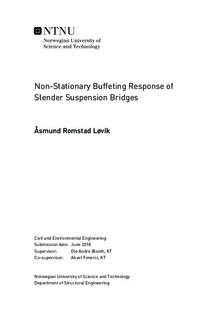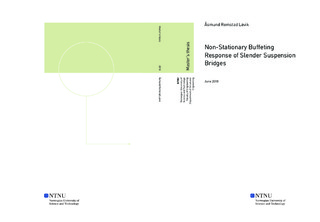| dc.description.abstract | This thesis presents a generalized framework for predicting dynamic structural response of slender, horizontal and line like structures. This general framework is subsequently adopted and streamlined to the Hardanger Bridge which crosses the Hardanger Fjord in Hordaland, Norway. During this process, several central arising issues regarding the non stationary theory is put onto the agenda.
The thesis itself is formulated in the following way. First, the general multi mode, frequency domain stationary buffeting theory is established in chapter 1, in which many concepts that are also vital in the formulation of the non-stationary theory are explained. Chapter 2 presents a detailed description of the proposed solutions to the issues that arises when the stationary frequency domain framework presented in chapter 1 is adapted to model non stationary winds. This process consists of three main steps in which the first one is to define the mean wind speed as being a deterministic, time varying trend. Second, the remaining turbulence component of the non stationary wind field is modelled as being an evolutionary stochastic process. The trends of this evolutionary process are similarly defined to be deterministic, time varying functions and are estimated in an appropriate manner. Finally, a good amount of attention is given to how the frequency spectrum of the stochastic turbulence components can be estimated as accurately and as wisely as possible. This involves the introduction of a simple and intuitive spectral data denoising algorithm that together with a weighted least square fit toolbox available in MATLAB R2018a that can operate on a user specified equation, is able to much more accurately determine the true frequency distribution of a scattered spectral data set. Chapter 3 presents the adaptation and streamlining of the established general non stationary buffeting theory framework to the Hardanger Bridge in particular. In order to obtain knowledge about transient effects in the dynamic structural response, a simplified SDOF system representing the fundamental mode of the Hardanger Bridge is applied from which structural response is calculated via time domain Monte Carlo simulations. A comparison between the frequency domain response and simulated time domain response of this simplified SDOF system provides the necessary information about when transient effects of the dynamic response of the Hardanger Bridge will prevail. The validity of this comparison is based on presented specific findings that suggest that horizontal motion at the bridge midspan is completely dominated by the fundamental mode alone.
The results of the case study of the Hardanger Bridge is given in chapter 4 from which discussions and conclusions are given in chapters 5 and 6, respectively. The major findings of this thesis are first that there exist many valid ways to draw the line between what one defines as being deterministic and stochastic, however, the probability distribution of maximum structural response seems to depend somewhat less on the location of this deterministic stochastic separation point. Second, the SDOF system is able to show that transient effects will start to become a significant feature of the airflow structure interaction picture if the highest included frequency in the deterministic mean wind speed is above roughly 1/50th of the fundamental frequency of the Hardanger Bridge. Above this limit, the validity of the frequency domain method is violated, and structural response seems to be overestimated. | |

